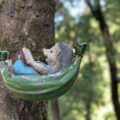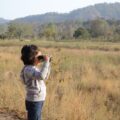As one of the inspirations for Rudyard Kipling’s The Jungle Book, Kanha National Park has a formidable reputation to live up to. And it does not disappoint. Kanha is a strikingly beautiful forest that is a treat for city-weary folks.
Nestled in the Maikal Hills of the Satpura Range in Madhya Pradesh, this national park spans nearly 2,000 square kilometres. While only 300 square kilometres are open to tourists, the park still gives a sense of being massive.
It is undoubtedly one of India’s most beautiful national parks with towering Sal trees that are home to hundreds of species of birds, including owls, eagles, vultures, and drongos. On the ground level, the lush forest opens up to the awe-inspiring Kanha meadow that extends as far as the eye can see.
Banjaar Tola, Kanha National Park
Positives
- Luxury Glamping
- Excellent Service
- Well-planned Excursions
- Jungle Location
- Delicious Food
Negatives
Breakdown
- Accommodation 5.0/5
- Service 5.0/5
- Food 5.0/5
- Amenities 5.0/5
- Location 5.0/5
The legendary barasingha or 12-tined antlered deer is endemic to the area and is visible foraging for aquatic plants at the waterholes scattered throughout the park. Herds of shy spotted deer, playful langurs and beautiful peacocks complete the ethereal picture.
The star attraction, no doubt, is a majestic yellow and black striped cat… the tiger, of course. Kanha is prime tiger country, and the thrill of seeing one in the wild is unbeatable.
Banjaar Tola – A Taj Safari Lodge
Situated at the very edge of the core zone of this beautiful national park is the Taj group’s tented safari lodge – Banjaar Tola – located only 10 minutes away from the park’s Mukki Gate.
“Tola” is the word for settlement in the local language, and Banjaar is the name of the river that cuts through the property.
This boutique safari lodge sits on a 90-acre property amidst a Sal forest. There are just 18 tents in total, split into nine tents each in the East and West Camp. Each camp has a separate common area, dining room, library, etc.
The Tents at Banjaar Tola
The tents themselves are expansive at nearly 800 square feet and earthy in decor with local Gond art and Bastar crafts adorning the walls. The construction is canvas and bamboo with minimal use of cement. While this creates a rustic atmosphere, there is no compromise on luxury.
Each safari tent has its own private deck overlooking the Banjaar River. The “manjis” (charpais or khatiyas) on the deck are inviting, especially in the mornings when it’s wonderful to relax in the fresh air to the sound of birdsong with a steaming pot of tea by your side.
The bathroom and vanity area in the tent is massive, perhaps larger than the room itself. There’s a standalone tub and shower area with louvred windows that create an atmosphere of being outdoors.
The Food at Banjaar Tola
The staff at Banjaar Tola set the benchmark in hospitality, above and beyond the legendary Taj standards. The service is flawless. We enjoyed two amazing dining experiences. One under a star-spangled sky below a lantern-bedecked harra tree. And the other, an intimate dinner on our tent’s private deck.
The food, while home style, is exceptional in taste and presentation. Particularly impressive were Head Chef Nim’s delicately flavoured soups.
My favourite culinary affair, though, was the resort-organized bonnet breakfast. A part of the morning safari, the opportunity to savour a delicious meal in the wilderness was truly an exceptional experience.
The Overall Experience at Banjaar Tola
The tents at Banjaar Tola are without TVs, and wifi is available only in the common area. Therefore, a stay at Banjaar Tola is an excellent opportunity to disconnect from all the noise and distractions of city life and reconnect with nature and yourself.
This luxury safari experience hit the sweet spot between staying true to the local area and offering unparalleled comfort. A memorable getaway that was made all the more special by the fantastic team at Banjaar Tola.
Good To Know
Kanha National Park is massive and can be accessed from three different gates. Banjaar Tola, located near the Mukki Gate, is roughly 200 km from both Raipur and Jabalpur. However, if you’re staying at a lodge near the other gates, Jabalpur is closer.
It’s important to book your safari drives as early as possible. They are controlled by the park authorities, and your lodge will arrange them for you. Moreover, it is typically impossible to get last-minute bookings.
The best time to visit Kanha, in my opinion, is February and March or October and November.
December and January see fewer crowds, but early morning game drives in an open jeep can be chilly (they’ll provide hot water bottles in the superbly comfortable Taj safari jeeps).
April, May, and June promise a higher chance of tiger sightings, but these months can be uncomfortably hot, with temperatures touching 45C. The park is closed between July and October for the annual monsoon season.
Lastly, the naturalists at the Taj property are a talented bunch and will do their best to locate a tiger for you, but of course, there are no guarantees. I would recommend that you keep expectations and hopes low and enjoy the beauty of Kanha, allowing the naturalists to regale you with interesting information about the local flora and fauna.
At the same time, always stay on the lookout and keep your fingers crossed, for a tiger might just make an appearance when you least expect it to.















